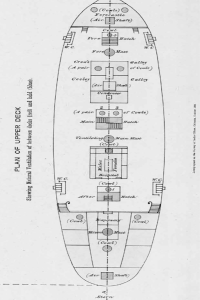By Ravi Dev
The emigrants were given a tin plate, a tin lota (vessel), two blankets, two dhotis, three shirts, two caps, and a bag as they walked onto the gangway of the ship that would take then to “tapu”. A tin tag with their registration number stamped on it was given each of them to wear around their necks. The medical staff and the protector of emigrants were present for the final medical inspection. One by one, the recruits were checked by different medical officers: one for physical signs of disease and fever; another touched the recruits’ stomach, while a third one picked up infants for inspection. The concern was that the recruit should be capable of working. After the recruits, some returning migrants boarded the ship too; they were resented because they warned migrants of what was ahead. 
Sailing ships remained the preferred type of ship until 1907, when British authorities decided the journey had to be completed within eleven weeks, rather than the twenty weeks considered acceptable since 1880. Steamships were faster and could carry more freight, but were also more expensive due to the cost of coal, and they were bound to refuel en route.
The ideal ship consisted of three levels, the lower hold was supposed to be used for cargo and storage. The migrants were accommodated between decks, in different compartments, with beds for single women, married couples and single men. Their decks were 5’6” high, and each person was given 2 feet of space. Facilities like the toilets, hospital, dispensary and galley were located on the main deck.
The separation between single women, couples and single men was a demand included in the Emigration Acts. Division based on gender and marital status was the main criterion for the organisation of the space between decks area, and it was similar to the segregation practised in the main depot. More than in the depot, the positioning of couples in between the single women and men formed an actual barrier.
Then there was the poop deck – over the captain’s cabin – situated at the rear of the ship. All levels, except the lower hold, were connected through stairs in this ship’s plan. In the figure where the layout of the main deck is depicted, it is indicated that there was supposed to be separate hospital accommodation for men and women, and that migrants and crew were to have separate galleys.
To each 25 persons, a sirdar or headman was appointed from the ranks of the emigrants. They were taught to supervise their ‘subordinates’; to maintain order; and at night, to accompany those leaving the deck. Besides lascars, or native/negro or mixed sailors, the crew consisted of sirdars, cooks, topasses, a barber, and hospital personnel. ‘topass’ or ‘topaz’ were sweepers engaged from among the migrants, who had to keep the decks and the toilets clean.
The crew not only used the main deck for work, but also had their living and sleeping quarters on this part of the ship. During daytime, the migrants were allowed on the main deck, while they were to remain in the between-decks area at night.
